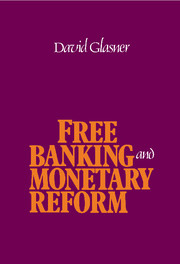Book contents
- Frontmatter
- Contents
- Preface
- Acknowledgments
- PART I A THEORY OF MONETARY INSTITUTIONS
- PART II THE UNCERTAIN PROGRESS OF MONETARY THEORY AND MONETARY REFORM
- PART III A COMPETITIVE MONETARY REGIME
- 8 The competitive breakthrough
- 9 Can competitive banking be safe and stable?
- 10 Why we need a new monetary regime
- 11 A proposal for monetary reform
- References
- Index
11 - A proposal for monetary reform
Published online by Cambridge University Press: 16 September 2009
- Frontmatter
- Contents
- Preface
- Acknowledgments
- PART I A THEORY OF MONETARY INSTITUTIONS
- PART II THE UNCERTAIN PROGRESS OF MONETARY THEORY AND MONETARY REFORM
- PART III A COMPETITIVE MONETARY REGIME
- 8 The competitive breakthrough
- 9 Can competitive banking be safe and stable?
- 10 Why we need a new monetary regime
- 11 A proposal for monetary reform
- References
- Index
Summary
Another plan is a convertible paper currency, the paper to be redeemable on demand, – not in any required weight or coin of gold, but in a required purchasing power thereof. Under such a plan, the paper money would be redeemed by as much gold as as would have the required purchasing power. Thus, the amount of gold obtainable for a paper dollar would vary inversely with its purchasing power per ounce as compared with commodities, the total purchasing power of the dollar always being the same. The fact that a paper dollar would always be redeemable in terms of purchasing power would theoretically keep the level of prices invariable.
Irving Fisher, The Purchasing Power of MoneyThe goal of monetary reform based on free banking poses a dilemma. On the one hand, the free market could provide us with a highly efficient, low-cost medium of exchange. But on the other hand, purely free-market moneys could not protect everyone from the costs of price-level uncertainty. Free-market moneys would minimize the costs of holding money, but they would not necessarily minimize the more general costs of price-level uncertainty. Those costs would still be borne by workers, employers, borrowers, lenders – indeed, by everyone who contemplates entering into commitments for the future exchange of values expressed in nominal terms.
- Type
- Chapter
- Information
- Free Banking and Monetary Reform , pp. 227 - 248Publisher: Cambridge University PressPrint publication year: 1989
- 3
- Cited by



